The WD Black2 Review: World's First 2.5" Dual-Drive
by Kristian Vättö on January 30, 2014 7:00 AM ESTRandom Read/Write Speed
The four corners of SSD performance are as follows: random read, random write, sequential read and sequential write speed. Random accesses are generally small in size, while sequential accesses tend to be larger and thus we have the four Iometer tests we use in all of our reviews.
Our first test writes 4KB in a completely random pattern over an 8GB space of the drive to simulate the sort of random access that you'd see on an OS drive (even this is more stressful than a normal desktop user would see). I perform three concurrent IOs and run the test for 3 minutes. The results reported are in average MB/s over the entire time. We use both standard pseudo randomly generated data for each write as well as fully random data to show you both the maximum and minimum performance offered by SandForce based drives in these tests. The average performance of SF drives will likely be somewhere in between the two values for each drive you see in the graphs. For an understanding of why this matters, read our original SandForce article.
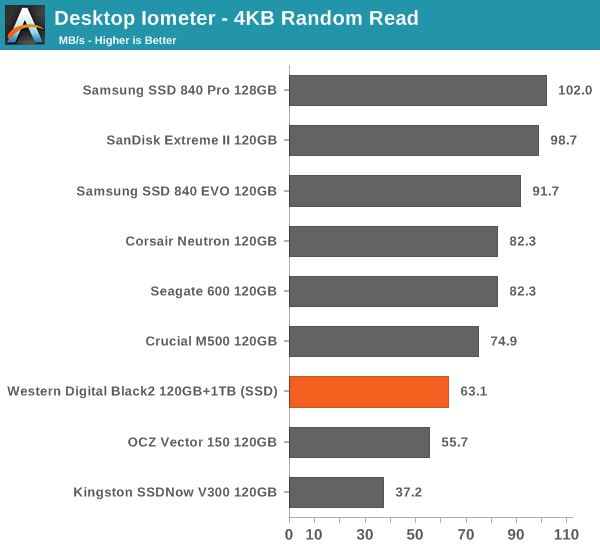

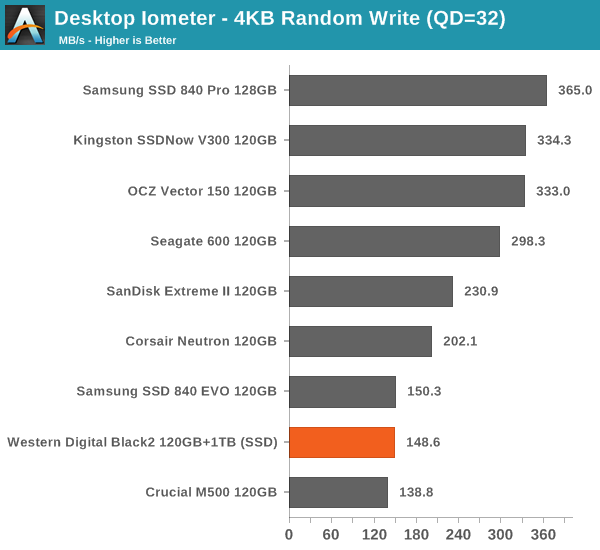
Random IO performance is relatively low per today's standards but not truly horrible. I was expecting something worse but the JMF667H turns out to be rather competitive with popular big brand drives like the Samsung 840 EVO and Crucial M500.
Sequential Read/Write Speed
To measure sequential performance I ran a 1 minute long 128KB sequential test over the entire span of the drive at a queue depth of 1. The results reported are in average MB/s over the entire test length.
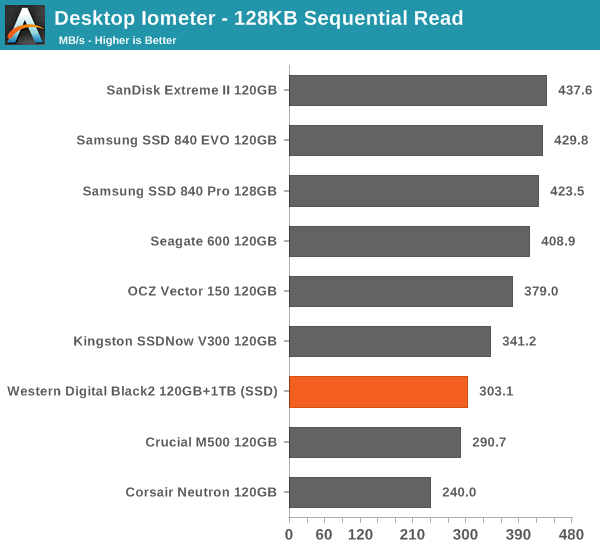
The same goes for sequential performance. It's not bad but there are far better options at 120/128GB.
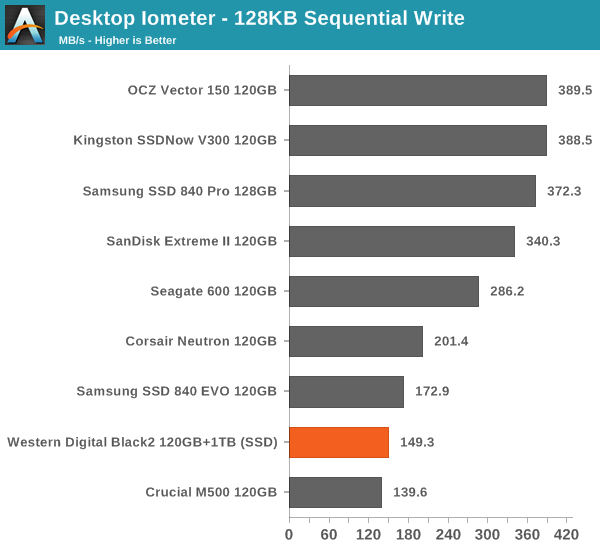
AS-SSD Incompressible Sequential Read/Write Performance
The AS-SSD sequential benchmark uses incompressible data for all of its transfers. The result is a pretty big reduction in sequential write speed on SandForce based controllers.
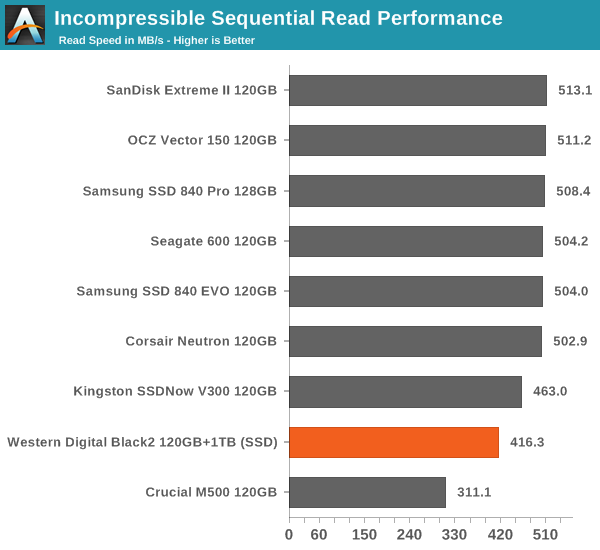











100 Comments
View All Comments
Crocodile2014 - Wednesday, February 5, 2014 - link
The Seagate Hybrid Drive could have been epic... it could have taken the market by storm... but it didn't. WHY? Because they overpriced the thing out of the market.A 500Gb Seagate Hybrid drive should have been priced very similar to a 500Gb Hard Drive + 8Gb of NAND. Instead we got a device priced at the level of a 500Gb Drive with a 30Gb SSD. Why did they do this?
I get you pay a "performance premium" but when the alternatives for better performance are cheaper, you've really missed the mark.
I suspect this drive by WD will also be a fail except for OEM's wanting a smaller package for their ultrabooks also based on the price.
SDKat - Friday, February 7, 2014 - link
Amazon has a best price of almost $300 for a 1TB HD with 120 gb SSD.FAR cheaper (by about half) to buy a 1 TB HD and separate SSD. AND more versatile too!
coder111 - Friday, February 7, 2014 - link
On scale of 1 to 10, how useless is this drive on Linux? If it needs special drivers to work properly, are these drivers available in Linux? Since which kernel version? Are they open-source or a buggy binary blob?If it works with Linux, does it show up as 2 separate drives, or as 1 combined accelerated drive? If it's 1 combined accelerated drive, how does the performance compare to having dedicated SSD + dedicated hard drive combined using Linux BCache or dm-cache?
ivan256 - Wednesday, February 12, 2014 - link
The Momentus XT is the least reliable hard drive I have ever experienced. The various iterations of it haven't improved on the situation much. I have seen failure rates of more than 50% in 18 months out of a sample size of hundreds of drives.The NAND wears out way sooner than it should. Failure isn't catastrophic, because there is a copy on the rotating media, but the NAND access failures slow the drive down to a more pathetic level than you would expect even from the slow legacy portion of the disk.
They need to get the reliability up to be taken seriously. And then they need to pair the tiny amount of flash with a much faster disk.
Haravikk - Monday, March 3, 2014 - link
I just don't get the point of these drives at all; okay, so putting the two drives into one bundle is neat, but the fact that you need software to actually run it is just bewildering. Why not include hardware on the disk to manage the split between SSD and HDD, and just let users configure that as either a SATA multiplier (two disk) or a hybrid disk as desired? Shipping it as a hybrid as standard would not only make it compatible with Linux and Mac computers too, but also make things so much easier.Instead you're getting two, not every good, individual disks in a single package. I mean, 350mb/sec sequential read is decent, but hardly amazing, plus that's competing with traffic going to the HDD at the same time.
It just seems a very messy way to produce a product that I'm not sure many people really need. I'd personally rather go with a (much cheaper) hybrid drive, assuming one 2.5" drive is all I can fit. While 8gb flash gives far from the hybrid SSD performance advertised, it's just so much simpler to setup and manage (no juggling of separate volumes) and works pretty well in real-world use.
A shame, I got really excited thinking WD were making a hybrid with 128gb of flash, i.e - something that would actually be really useful.
danwat1234 - Sunday, January 25, 2015 - link
I don't think the SATA protocol allows for more than 1 drive per channel. So, the drive couldn't have been designed to act as 2 separate drives to the controller.BDProductions - Thursday, May 1, 2014 - link
I have to wonder at the author's comment about his photos..WTF do you need a DSLR for to take great images?
Ever hear of a scanner?
- Set item on glass, cover with black velour, scan, instantly AWESOME images. (you may choose another solid color to cover the item, or even turn out the lights instead when you scan)
Some scanners do better than others for material not touching the glass, but most look better than the pictures in this article...
I have a question nobody seems to address... WHY IS THERE A MANDATORY DOWNLOAD instead of just putting the drivers on the USB thumbdrive? That makes no sense, other than to FORCE you to register the drive with WD.
That will keep me from buying such a product.
How stupid is it to make such an artificial requirement when a person might want to install the drive in a remote location where not even a cellular data connection would work? Just because anyone reading this has no such worry does not validate their theory that everyone these days MUST have an internet connection where ever they are... that just isn't true.
Some users may have remote locations with little more than power, and still NEED a replacement drive with the Black2's functionality for performance reasons.
Anyway, who has installed one and been able to save the "drivers" downloaded from WD at install time?
If you can save them, how big is the package, and why would it not make sense to have included the driver on the thumbdrive instead of a forced download?
Thanks,
Eric
bungle2000 - Tuesday, December 9, 2014 - link
Has there ever been a review of the Toshiba (500Gb/8Gb) Hybrid HDD SSD Drives on AnandTech?danwat1234 - Sunday, January 25, 2015 - link
It's down to $130 on Amazon/Newegg/Ebay! Now it's a great buy. Wish it had a 7200RPM drive thoughAseries - Friday, February 20, 2015 - link
I have two HP gaming laptops that have a mSATA slot with a 32 GB micro SSD installed running Raid 0 with the a 7200 RPM drive using Intel Rapidstore driver. Two years ago it was a reasonable solution. Laptop #1 has two 7200 RPM 1 TB drives in the two drive bays available. Today I would use a 240 GB SSD drive paired with the largest available 2.5 inch 5400 RPM drive. Laptop #2 has only one drive bay. Without the mSATA option I would definitely consider the WD solution.